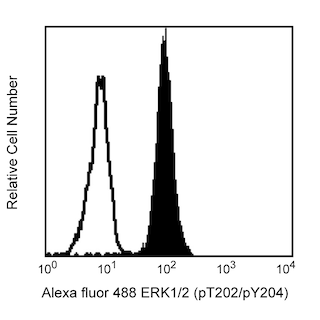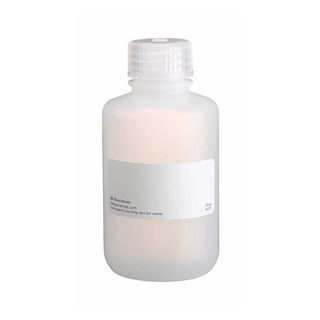Old Browser
Looks like you're visiting us from {countryName}.
Would you like to stay on the current country site or be switched to your country?




.png)

Analysis of Nestin expression in rat glioma. C6 cells (ATCC, Cat. No. CCL-107) were fixed (BD Cytofix™ buffer, Cat. No. 554655) for 20 minutes at room temperature, permeabilized with BD Phosflow™ Perm Buffer I (Cat. No. 557885), and then stained with either PE Mouse anti-Nestin (solid line) or PE Mouse IgG1, κ Isotype Control (Clone MOPC-21, Cat. No. 554680, dashed line). Flow cytometry was performed on a BD LSR™ II flow cytometry system. This antibody conjugate is also compatible with BD Phosflow™ Perm Buffers II and III.

Analysis of Nestin expression in human Neural Stem Cells (NSC). NSC were derived from H9 human embryonic stem cells (WiCell, Wisconsin) and grown for 8 passages, fixed (BD Cytofix™ buffer, Cat. No. 554655) for 20 minutes at room temperature, permeabilized with BD Phosflow™ Perm Buffer I (Cat. No. 557885), and then stained with either PE Mouse anti-Nestin (solid line) or PE Mouse IgG1, κ Isotype Control (Clone MOPC-21, Cat. No. 554680, dashed line). Flow cytometry was performed on a BD LSR™ II flow cytometry system. This antibody conjugate is also compatible with BD Phosflow™ Perm Buffers II and III.
.png)

BD Pharmingen™ PE Mouse anti-Nestin

BD Pharmingen™ PE Mouse anti-Nestin
.png)
Regulatory Status Legend
Any use of products other than the permitted use without the express written authorization of Becton, Dickinson and Company is strictly prohibited.
Preparation And Storage
Recommended Assay Procedures
This antibody conjugate is suitable for intracellular staining of human and rat cell lines using BD Cytofix™ Fixation Buffer and the BD Phosflow™ Permeabilization Buffers: Perm/Wash Buffer I, Perm Buffer II, or Perm Buffer III (see Suggested Companion Products).
Product Notices
- Please refer to www.bdbiosciences.com/us/s/resources for technical protocols.
- This reagent has been pre-diluted for use at the recommended Volume per Test. We typically use 1 × 10^6 cells in a 100-µl experimental sample (a test).
- An isotype control should be used at the same concentration as the antibody of interest.
- For fluorochrome spectra and suitable instrument settings, please refer to our Multicolor Flow Cytometry web page at www.bdbiosciences.com/colors.
- Caution: Sodium azide yields highly toxic hydrazoic acid under acidic conditions. Dilute azide compounds in running water before discarding to avoid accumulation of potentially explosive deposits in plumbing.
- Source of all serum proteins is from USDA inspected abattoirs located in the United States.
Companion Products





The cytoskeleton consists primarily of core structural proteins that include microfilaments, microtubules, and intermediate filaments (IFs). IFs contain more than 50 distinct proteins that are organized into six different subtypes: Type I/II keratins expressed in epithelia, type III vimentin/desmin, type IV neurofilament proteins, type V nuclear lamins, and type VI nestin expressed primarily in embryonic cells. Nestin has a conserved core region (amino acids 7 to 314), which contains an α helical domain that is involved in coiled-coil assembly of IFs. The C-terminal region of nestin is similar to type IV IFs, since it contains highly charged amino acids, many glutamate residues, and an 11 amino acid repeat motif. Nestin is expressed in the cerebrum during embryonic development, in the cerebellum during early postnatal development, and in dermatomal cells and myoblasts during myogenesis. In vitro, nestin forms homodimers and homotetramers, but not IFs, and can co-assemble with type III vimentin and type IV internexin proteins. Thus, nestin is a core IF protein that is essential for proper cytoskeletal formation during neurogenesis and myogenesis.

Development References (6)
-
Jin K, Zhu Y, Sun Y, Mao XO, Xie L, Greenberg DA. Vascular endothelial growth factor (VEGF) stimulates neurogenesis in vitro and in vivo. Proc Natl Acad Sci U S A. 2002; 99(18):11946-11950. (Clone-specific: Immunofluorescence). View Reference
-
Kachinsky AM, Dominov JA, Miller JB. Myogenesis and the intermediate filament protein, nestin. Dev Biol. 1994; 165(1):216-228. (Biology). View Reference
-
Kernie SG, Erwin TM, Parada LF. Brain remodeling due to neuronal and astrocytic proliferation after controlled cortical injury in mice. J Neurosci Res. 2001; 66(3):317-326. (Clone-specific: Immunofluorescence). View Reference
-
Lendahl U, Zimmerman LB, McKay RD. CNS stem cells express a new class of intermediate filament protein. Cell. 1990; 60(4):585-595. (Biology). View Reference
-
Steinert PM, Chou YH, Prahlad V, et al. A high molecular weight intermediate filament-associated protein in BHK-21 cells is nestin, a type VI intermediate filament protein. Limited co-assembly in vitro to form heteropolymers with type III vimentin and type IV alpha-internexin. J Biol Chem. 1999; 274(14):9881-9890. (Biology). View Reference
-
Wu D, Tadano M, Edamatsu H, et al. Neuronal lineage-specific induction of phospholipase Cepsilon expression in the developing mouse brain. Eur J Neurosci. 2003; 17(8):1571-1580. (Clone-specific: Immunofluorescence). View Reference
Please refer to Support Documents for Quality Certificates
Global - Refer to manufacturer's instructions for use and related User Manuals and Technical data sheets before using this products as described
Comparisons, where applicable, are made against older BD Technology, manual methods or are general performance claims. Comparisons are not made against non-BD technologies, unless otherwise noted.
For Research Use Only. Not for use in diagnostic or therapeutic procedures.
Refer to manufacturer's instructions for use and related User Manuals and Technical Data Sheets before using this product as described.
Comparisons, where applicable, are made against older BD technology, manual methods or are general performance claims. Comparisons are not made against non-BD technologies, unless otherwise noted.
Report a Site Issue
This form is intended to help us improve our website experience. For other support, please visit our Contact Us page.